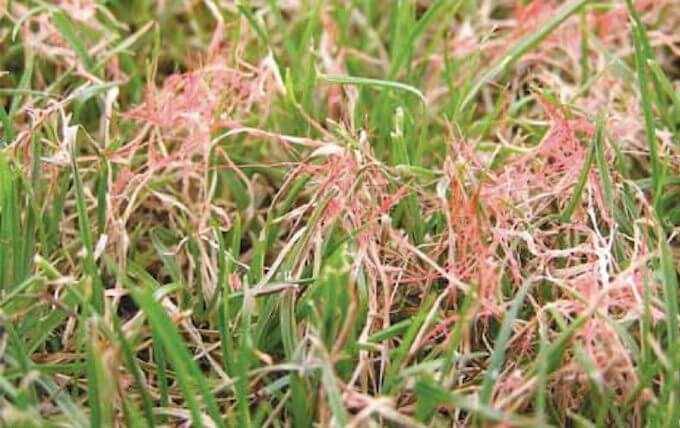Laetisaria fuciformis – Red thread
Red thread is a common fungal patch disease found on lawns in spring, early summer and autumn.
What does red thread look like?
The first thing you’ll notice if your lawn is suffering from red thread disease are irregularly shaped discoloured patches on the lawn. These areas start off small – perhaps the size of a 50p piece. But as the disease spreads, the areas will become larger and may even join up.
When you look closer, you’ll see that the patches are a distinctive pinky-brown colour.
Look closer still and you can see the little red threads that give this disease it’s name.
What causes red thread disease?
The disease is caused by a fungus. Scientific name Laetisaria fuctiformis
The microscopic spores of this fungus occur naturally in the thatch layer and in the soil. When conditions are right they will germinate. They infect the grass plants through the leaves and at the crown (where the leaves meet). Those little red threads you see are the fruiting body of the fungus and will drop spores back into the thatch layer. Spores will be washed down into the soil to begin their life cycle again.
This fungus tends to appear in spring and autumn. It likes a temperature of 12-25 degrees centigrade and wet conditions.
You are more likely to see red thread in your lawn if the soil is compacted and/or the grass is poorly nourished. Having said that, even the best maintained lawns can be affected by this disease.
In general, a healthy lawn is better able to resist the disease and will recover quicker if it is affected.

How to treat red thread disease
Quite often, red thread disease can be tackled by applying lawn feed. Occasionally though, it’s necessary to resort to using professional strength fungicides.
Lawn fungicides can be costly and need to be applied carefully. Using the wrong dose would simply mean that the next generation of the microbes are more resistant to the chemical.
While your lawn is coping with red thread disease, please try to avoid spreading it to other areas of the lawn. Try not to walk over the infected patches and always disinfect your mower blades after use.
At Premier Lawns we use fungicide as a very last resort and prefer to try management techniques first.
How to avoid red thread disease
Avoid a recurrence of the disease by making sure that your lawn is not somewhere the fungus likes to live.
You cannot control the weather, or the number of spores lying dormant in your soil. But there are steps you can take.
- Aerate your lawn regularly to ensure that it doesn’t lie wet for long periods of time.
- Regular aeration also promotes good root growth and helps improve the general health of your lawn
- Trim trees and hedges to reduce shade and improve air flow around your lawn. This helps excess moisture to evaporate and makes the lawn less attractive for the fungus.
- Scarify your lawn.Fungal spores can survive in the thatch for several years. Removing the thatch also removes the spores within it.
- Feed your lawn regularly so that it is in optimum health. An occasional seaweed tonic will also help to boost lawn health.
Contact Premier Lawns for help with managing Red Thread Disease
